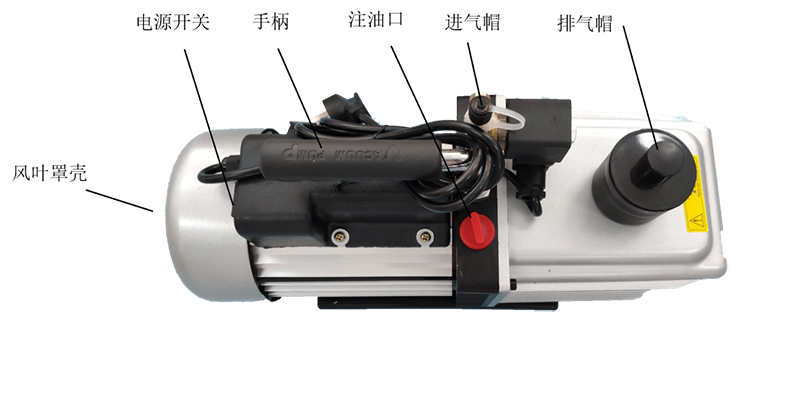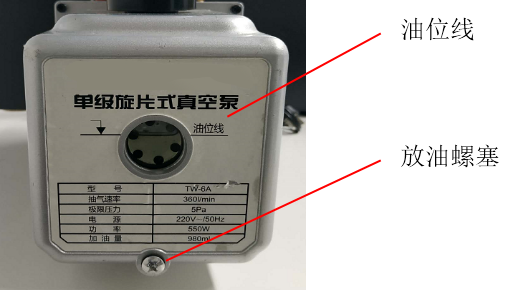A vacuum pump refers to a device or equipment that uses mechanical, physical, chemical, or physicochemical methods to evacuate a container and obtain a vacuum. In simpler terms, a vacuum pump is a device used in various ways to improve, generate, and maintain a vacuum in a closed space.
In the field of photocatalysis, it is used to bring the reaction system to a vacuum state, reduce interference from other gas impurities during detection, and, after each injection cycle is completed in the photocatalytic setup, a vacuum pump is required to evacuate the quantitative loop, preparing it for the next sampling.
Now, let's take the example of the vacuum pump used in the Labsolar-6A photocatalysis experiment to introduce the installation, use, and maintenance of the vacuum pump.
1. Explanation of the Components of the Vacuum Pump Used in Photocatalysis Experiments

Figure 1 Names of the Vacuum Pump Components
2. Parameters of the Vacuum Pump Used in Photocatalysis Experiments
Pumping Rate: 360 L/min
Ultimate Pressure: 5 Pa
Power Supply: 220 V~/50 Hz
Power: 550 W
Oil Capacity: 980 mL
3. Installation of the Vacuum Pump Used in Photocatalysis Experiments
(1) Place the vacuum pump horizontally in a dry, ventilated, and clean area, with a distance of more than 2 cm from the surroundings and more than 5 cm at the front and rear ends to ensure normal air intake at the fan hood;
(2) Secure the gasket at the intake port and connect the matching nut. Insert the hose for connection, and at the other end, connect it to the reaction system or reactor with vacuum requirements;
(3) If the extracted gas contains a large amount of water vapor, high temperature, or impurities such as dust, appropriate devices such as a cooler and filter should be added at the inlet pipe to avoid affecting the normal use of the vacuum pump.
4. Use of the Vacuum Pump Used in Photocatalysis Experiments
(1) Before use, remove the exhaust cap of the vacuum pump (TW-1 A/15 A/M models have no exhaust cap), and check the oil level line of the vacuum pump to ensure that the oil level is not below the oil level line. If it is lower, add vacuum pump oil promptly. It is recommended to use vacuum pump oil from the same brand as the vacuum pump;
(2) Remove the inlet cap, connect it to the reaction system or reactor with vacuum requirements. The connecting hose used should not be too long, and the seal should be reliable, with no leakage;
(3) Plug in the power plug, and turn on the switch to start. If there is an external triggering function, you can turn off the power switch during use and operate the vacuum pump through external triggering;
(4) After use, unplug the vacuum pump's power plug promptly, remove the connecting pipes, tighten the inlet cap, and replace the exhaust cap.
Note:In photocatalysis experiments, it is essential to regularly check the oil level window of the vacuum pump. If the vacuum pump oil becomes dirty, turbid, contains moisture, or other volatile substances, it will affect the ultimate vacuum value of the vacuum pump. In such cases, replace the pump oil promptly.

Figure 2 Vacuum Pump Oil Level Window
5. Maintenance of the Vacuum Pump Used in Photocatalysis Experiments
In photocatalysis experiments, it is necessary to keep the vacuum pump in normal working condition, capable of achieving the desired vacuum level. Careful maintenance is essential. Here are some maintenance considerations for the vacuum pump:
(1) Changing Vacuum Pump Oil:
(1) When changing to new vacuum pump oil, first run the vacuum pump for 30 minutes to thin the vacuum pump oil before turning off the vacuum pump;
(2) Unplug the vacuum pump's power plug and drain the vacuum pump oil from the oil drain hole of the vacuum pump;
(3) Add new vacuum pump oil to the oil level line from the vacuum pump's oil filling port to clean the oil in the vacuum pump chamber;
(4) Tighten the oil drain plug, connect the vacuum pump's power plug, and run the vacuum pump for 1-2 minutes;
(5) Repeat the cleaning process several times, confirm that the pump is clean, then tighten the oil drain plug and add clean pump oil to the oil level line from the vacuum pump's oil filling port.
Daily Maintenance of the Vacuum Pump Used in Photocatalysis Experiments:
(1) Keep the vacuum pump clean to prevent foreign objects from entering the pump;
(2) Maintain the oil level in the vacuum pump, and never operate it without oil;
(3) If the vacuum pump oil becomes emulsified, dark, or shows clear oil-water separation, replace the vacuum pump oil promptly. For normal use, it is recommended to replace the vacuum pump oil every 2-3 months;
(4) When not in use for an extended period, cover the inlet and exhaust caps, store it in a dry place, and take measures to prevent moisture and rust.
6. Precautions for the Vacuum Pump Used in Photocatalysis Experiments
(1) Strictly avoid pumping flammable, explosive, and toxic gases;
(2) Do not pump gases that can corrode metals or undergo chemical reactions with pump oil;
(3) Do not pump gases containing particulate dust and excessive water vapor;
(4) The temperature of the pumped gas should not exceed 80°C, and the operating environment temperature is -5°C to 60°C;
(5) Do not use it as a compression pump or conveying pump;
(6) Absolutely do not run the vacuum pump without oil;
(7) When the vacuum pump is running, do not block the exhaust cap;
(8) When unplugging the power, always hold the plug and avoid pulling on the power cord. The socket must be grounded;
(9) Do not place heavy objects on the power cord, and avoid crushing the power cord;
(10) Do not use damaged plugs and sockets;
(11) Do not plug or unplug the power plug or press the switch with wet hands;
(12) Do not plug or unplug the power plug or press the switch in areas with gas leaks.
The above information covers the use and maintenance of the vacuum pump used in photocatalysis experiments. If you encounter any other issues with the vacuum pump in photocatalysis experiments, you can contact customer service on the website for assistance.